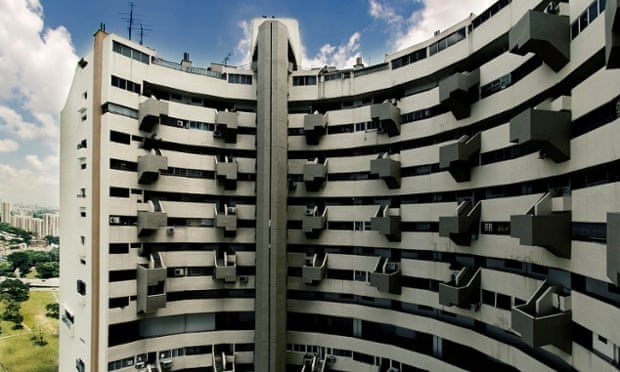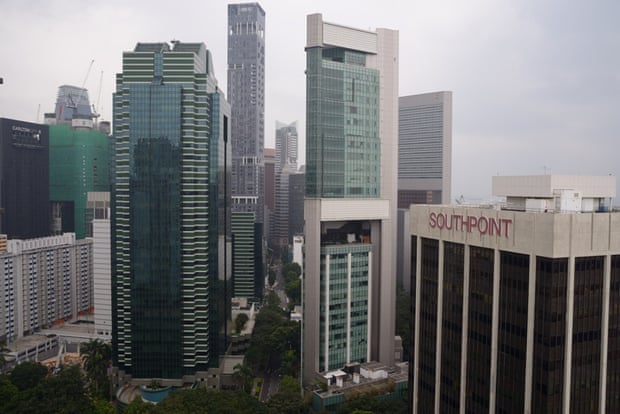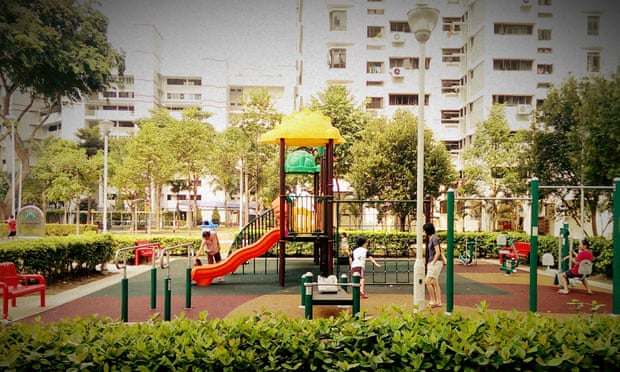The old, the new and the renovated make for a rich panorama of structural design in Singapore. Architect Tiah Nan Chyuan takes in the forest, as well as decaying industrial zones
As the founder and director of Farm, a firm that riffs between architecture, branding and industrial design, Tiah Nan Chyuan is at the vanguard of a generation of young designers devoted to the preservation and sympathetic modernisation of living spaces in Singapore. His Wheelers Yard project, for instance, transformed a run down industrial building owned by an old family business that wanted to re-engage its younger family members. Here are his favourite designs in Singapore.
Interlace
This upmarket condominium is one of the most intriguing by the recent wave of global architects making their mark in Singapore. It’s by Ole Scheeren and I love it for the clarity of its design. Some people harp on about the facade’s lack of finesse, but that misses the point.

The composition itself is audaciously simple and suggests new ways for private and communal spaces to be connected. It’s a defiant break from the typical tower block configuration for residential developments in Singapore. It’s a pity, though, that this is not a public building where more people can experience the space.
• 180-226 Depot Road, www.theinterlace.com
Pearl Bank
No list of Singaporean designs is complete without the Pearl Bank. The scale of the building is monumental. Like all of the greatest works by the pioneering architects in Singapore in the 1960s and 70s, the building reflects a sense of purpose. Set on a hill, Pearl Bank’s architect, Tan Cheng Siong, showed us, in a deceptively simple gesture, his vision for the future of Asian cities.

Externally, the singular form, designed entirely without computers, hides all its complexities. I remember looking at the plans and trying to figure out how the split level units interlocked across each floor and I couldn’t. As architecture students, we called it the Death Star.
• 1 Pearl Bank Road
Tower 15
Not many people know this building. I call it the Table Top and it’s absolutely fascinating. At the base is the original 15-storey building. To increase the site’s square footage they built another 10-storey structure over it, like a table. The new cores, which are the legs, rise 16 floors to clear the roof of the existing building before massing together to form the base for the new one.

It’s totally crazy, but someone worked it out and managed to convince the owner to accept the idea. It’s something that’s straight out of a sci-fi manga.
• 15 Hoe Chiang Road, towerfifteen.com
Henderson Wave
The Southern Ridges is one of the more interesting public projects of recent years. The ambitious plan links five existing hills, ridges and parks with a 10km trail that takes in historical sites and mature tropical rainforest.

A series of bridges was commissioned, one of which is the wonderful Henderson Wave by London-based IJP Corporation and RSP Architects Singapore. It takes two hours to walk from one end of the Ridges to the other, during which you will be trekking through the forest at tree-top level, or crossing a road at 30 metres in the sky. In Singapore, we don’t have any genuine mountain trails to speak of, but I love this fascinating combination of urban and nature.
• Henderson Road, nparks.gov.sg
Kilo Lounge
I love this spot. It’s located on the top floor of an ancient industrial building near the old Kallang gasworks. It’s only open at night, which is also the best time to go: the city lights fill up the mood-lit lounge which feels more like someone’s home than a commercial bar.

The space is casually filled with restored sofas and loungers. I especially love riding the old, restored industrial lift.
• 66 Kampong Bugis #08-01, kilokitchen.com
Eco Gourmet Cafe
Designed like an open shed, the Thai-inspired Eco is tucked away in the middle of lush tropical forest in one of Singapore’s oldest parks. You can’t really drive to it. It’s built on a cliff and you need to hike up a path from the public car park which, in a country where no one walks if they can help it, adds to the adventure of getting there.

The naturally ventilated dining area makes such a change from Singapore’s chilly air-conditioned restaurants, and overlooks a mass of greenery. You really feel as if you’re in a treehouse. Everything just feels so calm and quiet.
• 30 Labrador Villa Road, Facebook page
Lor 24A Shophouse Series
This is Singapore’s version of the Case Study Houses, built in the US in the 1940s. A row of eight conserved shophouses along the same street was given a radical makeover by seven architects. The owners are all friends, and the project was envisaged as a regenerative programme in an otherwise seedy part of town. Each architect was given a working budget and the same brief: interpret architecture as art. My firm was one of the lucky seven.

The project took about two years to complete. It not only featured exciting new possibilities of living and working in a conserved shophouse, it also showcased the architects’ different approaches and design techniques. Given the freedom to imagine, the collective outcome was refreshing. Open houses and exhibitions are held regularly.
• Lorong 24 A, Geylang, thelor24ashophouseseries.com
Satay by The Bay
Situated next to the biodomes at Gardens by the Bay, this waterfront version of a hawker centre won the President Design Award last year. Designed by Ling Hao Architects, the open-plan space features an articulated roof, a raw concrete canopy that provides shelter from sun and rain, and a rooftop garden which always seems to be in danger of being overrun by the hanging vines and creepers.

Dining here takes me back to the good old days of eating outdoors rather than the modern trend of being stuck in the basement food court of an air-conditioned shopping mall. It’s rarely crowded, which adds to the laid-back vibe. The open air section with the low slung tables and little stools is incredibly nostalgic.
• 18 Marina Gardens Dr, #01-19, open 24/7, sataybythebay.com.sg
Blk 6 Marine Terrace playground
It looks like any other public housing playground, but this one is very special to me because I used to play here as a kid. Now I bring my kids here every weekend. The sand pits and mosaic pelican are gone now, and the slides are new, the trees are bigger, there are new exercise machines with grab bars for older people, and a foot reflexology rock path.

Yet the space feels strangely familiar and intimate. I think it has a lot to do with its scale. Someone sat down and designed the playground as a multi-generational space, and you really do see people of all ages here. Kudos to the silent architects who design and maintain public spaces like this by keeping them relevant for the whole community.
• Marine Parade
Benjamin Sheares bridge
For me, driving on this bridge is one of the greatest pleasures of living in Singapore. Regardless of the time of day or the direction you’re going, the views are always spectacular. Coming from the airport, the entire city skyline opens up before you descend and weave past the beautiful ivy-clad columns and the underbelly of the bridge into the city streetscape.

I can’t think of a more dramatic entrance to a city than this. I understand the bridge was built to such a height (20 metres) so as to allow ships to pass below; there was an operational shipyard in Kallang Basin at the time. The shipyard has since been relocated.
• Marina Bay
Interview by Daven Wu
Sponsored by Your Singapore (yoursingapore.com).



















